|
|
|

Online Gallery of Artists at Heritage Gallery
Please note,
the artists listed below are a smaller portion of artists than all
who are represented with Heritage Gallery. This is an online galley
of examples of some of the artists and artwork represented, it is
not a full listing. Please enjoy reading biographical exerpts about
the following artists, and to learn more, and see example artwork
for these artists, click on their names, or on the thumbnail of
their artwork.
Also, feel free to bookmark this page, and check back frequently, as these pages will be updated often.
|
| - MASTER ARTISTS AT HERITAGE GALLERY- |
Charles
Wilbert White (1918-1979) |
back to the top |
|
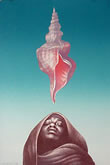 Charles
W. White, born in 1918, is one of America's most renowned and recognized
African American and Social Realist artists. Working primarily in
black/white and sepia/white, he encompassed an incredibly skilled
draftsmanship and artistic sensitivity and power that has reached
and moved millions. Charles
W. White, born in 1918, is one of America's most renowned and recognized
African American and Social Realist artists. Working primarily in
black/white and sepia/white, he encompassed an incredibly skilled
draftsmanship and artistic sensitivity and power that has reached
and moved millions.
His meticulously executed drawings and paintings speak of and affirm
the humanity and beauty of African American people and culture.
He received numerous honors and awards and has been exhibited at
the Art Institute of Chicago, Whitney Museum, Metropolitan Museum, Smithsonian Institution, National Academy of Design, and elsewhere throughout the world. He was elected to the National Academy of Design in 1972. The Heritage Gallery had represented Charles White from the early 1960s, when Mr. Horowitz provided Mr. White his first show in Los Angeles, California.
|
| Visit gallery of artwork for Charles Wilbert White |
William Gropper (1897-1977) |
back to the top |
|
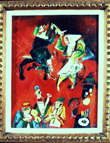 William
Gropper, a major painter of Social Realism and illustrator of political
cartoons, was born in New York City in 1897. He studied with Robert
Henri and George Bellows. He took realistic art and turned it into
pungent critique of the ills of modern society. He spoke of the
hypocrisy of its leaders, most notably members of the government
in Washington. At the same time, his sympathy for the laborer, the
displace person, and the underdog gave his art a humanitarian warmth
that muffled any propagandistic shrillness. His incisive views are
still relevant as we approach the 21st century. His works are in
most major collections, including the Museum of Modern Art, New
York, Whitney Museum of American Art, and the Metropolitan Museum. William
Gropper, a major painter of Social Realism and illustrator of political
cartoons, was born in New York City in 1897. He studied with Robert
Henri and George Bellows. He took realistic art and turned it into
pungent critique of the ills of modern society. He spoke of the
hypocrisy of its leaders, most notably members of the government
in Washington. At the same time, his sympathy for the laborer, the
displace person, and the underdog gave his art a humanitarian warmth
that muffled any propagandistic shrillness. His incisive views are
still relevant as we approach the 21st century. His works are in
most major collections, including the Museum of Modern Art, New
York, Whitney Museum of American Art, and the Metropolitan Museum.
Gropper’s best-known subject matter is the satiric caricature of America's wealthy and powerful, of politicians, and moguls of business and industry. In this era, his art is so relevant, It is, as though, the cycle has come in its full circle, pointing out the relevant elements that have made our society go wrong for the people. Ironically it was and wealthy collectors who sought these images for their collections. Now the paintings, drawings and prints are purchased by collectors who see his meaning in today's world.
|
| Visit gallery of artwork for William Gropper |
David
Alfaro Siqueiros (Mexican, 1898-1974) |
back to the top |
|
 David Alfaro Siqueiros is one of Mexico's most important artists. Born in Chihuahua, Mexico, the artist attended the Open Air Art School in Santa Anita, Mexico. In 1914, he enlisted in the army, fighting in the Mexican Revolution. He painted his first mural in 1923, the beginning of a long career that would make him famous throughout Mexico and the United States. The Santa Barbara Museum of Art recently celebrated the installation of a Siqueiros mural that had been moved from a private home in Pacific Palisades. Another important mural painted in downtown Los Angeles is now being restored by the Getty Museum. David Alfaro Siqueiros is one of Mexico's most important artists. Born in Chihuahua, Mexico, the artist attended the Open Air Art School in Santa Anita, Mexico. In 1914, he enlisted in the army, fighting in the Mexican Revolution. He painted his first mural in 1923, the beginning of a long career that would make him famous throughout Mexico and the United States. The Santa Barbara Museum of Art recently celebrated the installation of a Siqueiros mural that had been moved from a private home in Pacific Palisades. Another important mural painted in downtown Los Angeles is now being restored by the Getty Museum.
David Alfaro Siqueiros is receiving more recognition this year than ever before in his history. Museums in Los Angeles, as well as in other major cities in the United States in recognition of the Centennial of the Mexican Revolution and the Bi-Centennial of Independence are mounting major exhibitions. Museums have chosen to highlight the art of this great Mexican Master artist. He is known as one the three Mexican Master artists along with Diego Rivera and José Clemente Orozco. To name a few of the exhibits of Siqueiros' art to be held are the Museum of Latin American Art, the Autry National Center of the American West, along with the recognition of his famous mural America Tropical at the Getty Center and the Los Angeles County Museum. Organized by Mexico's most illustrious museum, Museum of Modern Art in Mexico City, a massive exhibit will be touring the United States.
|
| Visit gallery of artwork for David Alfaro Siqueiros |
Raúl Anguiano (Mexican, 1915-1999) |
back to the top |
|
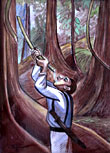 Over the course of eight decades, Anguiano was a prolific artist who created a diverse body of work in Mexico that both portrayed an ancient and a modern Mexico, and many spaces in between. Generations: Paintings by Raúl Anguiano includes works that portray Pre-Columbian art, women of different ages and lifestyles, the contemporary indigenous population, and enduring landscapes. Over the course of eight decades, Anguiano was a prolific artist who created a diverse body of work in Mexico that both portrayed an ancient and a modern Mexico, and many spaces in between. Generations: Paintings by Raúl Anguiano includes works that portray Pre-Columbian art, women of different ages and lifestyles, the contemporary indigenous population, and enduring landscapes.
His work remained important in Mexico as he forms a direct link to the work of the famed muralists José Clemente Orozco, Diego Rivera, and David Alfaro Siqueiros. Often classified as a second-generation muralist, he was younger than Los Tres Grandes and therefore continued with the important tradition of mural making by creating large-scale works in Mexico and the United States.
|
| Visit gallery of artwork for Raúl Anguiano |
Joseph Mugnaini (American, 1912-1992) |
back to the top |
|
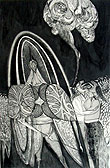 Joseph Mugnaini was was an artist and illustrator, born in Viareggio, Italy on July 12, 1912. A few months after his birth, Mugnaini arrived in the United States with his family. Settling in Los Angeles, he studied at the Otis Art Institute. Following service in the Army during World War II, he returned to Otis as an instructor and taught there until retirement in 1976. One of his pupils was Norman Rockwell. Mugnaini died in Los Angeles on Jan. 23, 1992. Joseph Mugnaini was was an artist and illustrator, born in Viareggio, Italy on July 12, 1912. A few months after his birth, Mugnaini arrived in the United States with his family. Settling in Los Angeles, he studied at the Otis Art Institute. Following service in the Army during World War II, he returned to Otis as an instructor and taught there until retirement in 1976. One of his pupils was Norman Rockwell. Mugnaini died in Los Angeles on Jan. 23, 1992.
Member: Painters & Sculptors of LA. Exh: LA Public Library, 1947; Chabot Gallery (LA), 1949; Compton Art Center, 1951; LACMA, 1951; Pasadena Art Inst., 1954; LA AA, 1955; Glendale AA, 1958; Sierra Madre Public Library, 1959 (solo); Valley Art Center (Encino), 1962; Orange Coast College, 1974; Heritage Gallery (LA), 1976, 1983. In: LACMA; University of Hawaii; Temple University; Library of Congress; Pasadena Museum.
|
| Visit gallery of artwork for Joseph Mugnaini |
José Clemente Orozco (Mexican, 1883-1949) |
back to the top |
|
 José Clemente Orozco, born in 1883, was a Mexican muralist, genre painter, and lithographer, and a graduate of the Mexican National Agricultural School. He became an architectural draftsman, and in 1908 turned to painting. With Diego Rivera, he led the renaissance of modern Mexican Art. Orozco's work is bold in execution, often brilliant in color, and deals compassionately with social themes, especially human versus machine. From 1917 to 1919 and from 1927 to 1934, Orozco was in the United States. Much of his work is true fresco painting, executed directly on wet plaster, such as his 1930 mural Mankind's Struggle at New School University in New York City. His work in the United States also includes Prometheus (Frary Hall, Pomona College, Calif.) and Epic of Culture in the New World (Baker Library, Dartmouth College). There are also several fine murals in Mexico, such as those at the Palace of Fine Arts in Mexico City and at Guadalajara in the university, governor's palace, and cultural institute. José Clemente Orozco, born in 1883, was a Mexican muralist, genre painter, and lithographer, and a graduate of the Mexican National Agricultural School. He became an architectural draftsman, and in 1908 turned to painting. With Diego Rivera, he led the renaissance of modern Mexican Art. Orozco's work is bold in execution, often brilliant in color, and deals compassionately with social themes, especially human versus machine. From 1917 to 1919 and from 1927 to 1934, Orozco was in the United States. Much of his work is true fresco painting, executed directly on wet plaster, such as his 1930 mural Mankind's Struggle at New School University in New York City. His work in the United States also includes Prometheus (Frary Hall, Pomona College, Calif.) and Epic of Culture in the New World (Baker Library, Dartmouth College). There are also several fine murals in Mexico, such as those at the Palace of Fine Arts in Mexico City and at Guadalajara in the university, governor's palace, and cultural institute.
|
| Visit gallery of artwork for José Clemente Orozco |
James C. McMillan (American, 1925-present) |
back to the top |
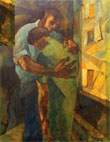 James McMillan was born in North Carolina in 1925. His education includes Howard University, and Skowhegan School of Painting. McMillan studied in Paris at the Acadèmie Julian in 1950. On his return, he resumed his Chair of the Art Department at Bennett College. James McMillan was born in North Carolina in 1925. His education includes Howard University, and Skowhegan School of Painting. McMillan studied in Paris at the Acadèmie Julian in 1950. On his return, he resumed his Chair of the Art Department at Bennett College.
Exhibits are too numerous to list, a partial list: Showhegan School of Art, 1947; Salon de L'Armee, Paris, 1951; Smithsonian Institution, Washington, D.C. 1954; Corcoran Gallery, Washington, D.C., 1954; Retrospective, Images and Impressions, James McMillan, A&T State University Gallery, Greensboro, North Carolina, 2006.
Two James McMillan exhibits have recently opened in Greensboro, North Carolina with double venue exhibits at the African American Atelier and the Bennett College Museum. To find out more about these exhibits and to see examples of James McMillan's work, visit his Heritage Gallery artist's page.
Click Here for James McMillan's recent catalogue (pdf format)
James McMillan's art is available for one-man exhibitions.
|
| Visit gallery of artwork for James C. McMillan |
Charlotte Sherman (Z. Charlotte Sherman) (American, 1925-present) |
back to the top |
 Z. Charlotte Sherman is a painter, printmaker, and sculptor who was born in 1924 in Los Angeles, California. The style of her work is Abstract Impressionism and Expressionism. Her preferred media is oil, watercolor, pen and ink, printmaking (etchings & lithographs), and bronze sculpture. Z. Charlotte Sherman is a painter, printmaker, and sculptor who was born in 1924 in Los Angeles, California. The style of her work is Abstract Impressionism and Expressionism. Her preferred media is oil, watercolor, pen and ink, printmaking (etchings & lithographs), and bronze sculpture.
She has painted in Asia, Europe, and the Middle East, and she studied at UCLA, Otis Art Institute where she earned three scholarship awards, and the Kann Art Institute: graduate studies at UCLA.
|
| Visit gallery of artwork for Z. Charlotte Sherman |
George Chann (Chinese American, 1913–1995) |
back to the top |
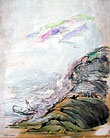 George Chann was born in Canton, China on Jan. 1, 1913. After arriving in California in 1922, Chann lived briefly in Stockton. By the late 1920s he had moved to San Francisco and in the early 1930s he was living nearby in San Mateo. Shortly thereafter, he moved to Los Angeles where he studied at the Otis Art Institute on scholarships during 1934-41. Chann died in Los Angeles on May 26, 1995. George Chann was born in Canton, China on Jan. 1, 1913. After arriving in California in 1922, Chann lived briefly in Stockton. By the late 1920s he had moved to San Francisco and in the early 1930s he was living nearby in San Mateo. Shortly thereafter, he moved to Los Angeles where he studied at the Otis Art Institute on scholarships during 1934-41. Chann died in Los Angeles on May 26, 1995.
Exh: Calif. Art Club, 1941 (solo); CPLH, 1942, 1944 (solos); LACMA, 1942 (solo), 1943; De Young Museum, 1944 (solo); Foundation of Western Art (LA), 1945. His art was represented in Los Angeles at the Joan Ankrum Gallery and the Heritage Gallery in the 1960s through the 1980s on La Cienega Blvd, Los Angeles.
The value of Chann's paintings has risen exponentially. Chinese Contemporary Art has been collected in China, Europe, and the United States.
|
| Visit gallery of artwork for George Chann |
Margaret Burroughs (African American, 1917) |
back to the top |
|
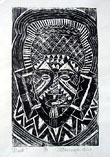 Margaret Taylor Goss Burroughs is an African American poet, visual artist, educator, and arts organizer. Margaret Burroughs was born in St. Rose, Louisiana, near New Orleans, but was brought at the age of five by her parents, Alexander and Octavia Pierre Taylor, to Chicago where she grew up, was educated, and where her distinctive career has unfolded. She attended the public schools of Chicago, including the Chicago Teacher's College. In 1946, she received a BA in education and in 1948, an MA in education from the Art Institute of Chicago. From 1940 to 1968 she was a teacher in the Chicago public schools and subsequently a professor of humanities at Kennedy-King College in Chicago (1969–1979). Margaret Taylor Goss Burroughs is an African American poet, visual artist, educator, and arts organizer. Margaret Burroughs was born in St. Rose, Louisiana, near New Orleans, but was brought at the age of five by her parents, Alexander and Octavia Pierre Taylor, to Chicago where she grew up, was educated, and where her distinctive career has unfolded. She attended the public schools of Chicago, including the Chicago Teacher's College. In 1946, she received a BA in education and in 1948, an MA in education from the Art Institute of Chicago. From 1940 to 1968 she was a teacher in the Chicago public schools and subsequently a professor of humanities at Kennedy-King College in Chicago (1969–1979).
Burroughs has a national reputation as a visual artist and as an arts organizer. Her long exhibition record as a painter and printmaker began in 1949 and has included exhibitions throughout the United States and abroad. A retrospective of her work was held in Chicago in 1984. As an organizer she has been associated with the founding and conduct of a number of arts organizations. It was her founding in 1961 of the DuSable Museum of African-American History, however, that placed her among the outstanding institution builders of her generation. She served as a director of the museum until her appointment as a Commissioner of the Chicago Park District in 1985.
|
| Visit gallery of artwork for Margaret Burroughs |
Isaac Soyer (1902 -1981) |
back to the top |
|
 Russian-American
genre scene painter Isaac Soyer specialized in portraits, interiors,
and dancers. He was born in 1902 in Tombrov, Russia and along with
his family emigrated to the United States in 1912. Russian-American
genre scene painter Isaac Soyer specialized in portraits, interiors,
and dancers. He was born in 1902 in Tombrov, Russia and along with
his family emigrated to the United States in 1912.
Isaac had two older twin brothers, Raphael Soyer (1899-1987), and Moses Soyer (1899-1974), (b. Borisoglebsk), who were also artists. They settled in New York City, inspired by everyday attitudes, thoughts, and gestures of people performing everyday tasks.
|
| Visit gallery of artwork for Isaac Soyer |
Moses
Soyer (1899-1974) |
back to the top |
|
 Moses
Soyer was the twin brother of artist Raphael Soyer and older brother of artist Isaac Soyer. They were born in 1899 in Tombov, Russia and came to the U.S. in 1912.
M. Soyer studied in New York City at the Cooper Union, the National
Academy of Design, the Educational Alliance, and the Ferrer School,
all between 1916 and 1920. His work extends into the present Rembrandt's
warm, expressive, and humanistic portraits and interiors. Like his
brother Raphael, he did many self-portraits. During the 1930s and
1940s he depicted the effects of the Depression on the unemployed
and the underprivileged. During the 1940s, he portrayed many dancers,
often in poses, and often with a measure of melancholy. His works
are found in major U.S. museums, including the Los Angeles County
Museum of Art, the Metropolitan Museum, and the Whitney Museum of
American Art. Moses
Soyer was the twin brother of artist Raphael Soyer and older brother of artist Isaac Soyer. They were born in 1899 in Tombov, Russia and came to the U.S. in 1912.
M. Soyer studied in New York City at the Cooper Union, the National
Academy of Design, the Educational Alliance, and the Ferrer School,
all between 1916 and 1920. His work extends into the present Rembrandt's
warm, expressive, and humanistic portraits and interiors. Like his
brother Raphael, he did many self-portraits. During the 1930s and
1940s he depicted the effects of the Depression on the unemployed
and the underprivileged. During the 1940s, he portrayed many dancers,
often in poses, and often with a measure of melancholy. His works
are found in major U.S. museums, including the Los Angeles County
Museum of Art, the Metropolitan Museum, and the Whitney Museum of
American Art.
|
| Visit gallery of artwork for Moses Soyer |
Raphael
Soyer (American, 1899-1988) |
back to the top |
|
 Raphael
Soyer was the twin brother of artist Moses
Soyer and older brother of artist Isaac Soyer. They were born in 1899 in Tombov, Russia and came to
the U.S. in 1912. R. Soyer studied art in New York at the Cooper
Union, the National Academy of Design, and the Art Students League.
His favored themes are urban views (such as Sixth Avenue), interiors,
and quiet moments in the lives of people. He also worked in the
print media, etchings, and lithographs. After 1940, he began to
concentrate on studies of women at work or posing in the studio.
His paintings and prints are in almost all major U.S. museums, including
the Metropolitan Museum of Art, the Whitney Museum of American Art,
and the Los Angeles County Museum of Art. Raphael
Soyer was the twin brother of artist Moses
Soyer and older brother of artist Isaac Soyer. They were born in 1899 in Tombov, Russia and came to
the U.S. in 1912. R. Soyer studied art in New York at the Cooper
Union, the National Academy of Design, and the Art Students League.
His favored themes are urban views (such as Sixth Avenue), interiors,
and quiet moments in the lives of people. He also worked in the
print media, etchings, and lithographs. After 1940, he began to
concentrate on studies of women at work or posing in the studio.
His paintings and prints are in almost all major U.S. museums, including
the Metropolitan Museum of Art, the Whitney Museum of American Art,
and the Los Angeles County Museum of Art.
|
| Visit gallery of artwork for Raphael Soyer |
Ernie Barnes (American, 1938-present) |
back to the top |
|
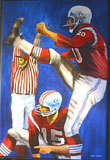 Ernie
Barnes, born in 1938, was a professional football player and artist.
He played lineman position for the New York Titans (c. 1961), the
San Diego Chargers (1962), the Dever Broncos (1963-64), and in the
Canadian Football League (c. 1965). His first exhibition of artwork
was at New York City's Grand Central Art Galler (1966). Barnes has
also exhibited paintings at the California Museum of Science and
Industry and Heritage Gallery, Los Angeles (c. 1972). His art is
known for his American Modernist style. Ernie
Barnes, born in 1938, was a professional football player and artist.
He played lineman position for the New York Titans (c. 1961), the
San Diego Chargers (1962), the Dever Broncos (1963-64), and in the
Canadian Football League (c. 1965). His first exhibition of artwork
was at New York City's Grand Central Art Galler (1966). Barnes has
also exhibited paintings at the California Museum of Science and
Industry and Heritage Gallery, Los Angeles (c. 1972). His art is
known for his American Modernist style.
|
| Visit gallery of artwork for Ernie Barnes |
Hans Burkhardt (1904-1994) |
back to the top |
|
 The artist Hans Burkhardt was born in Switzerland and studied at the Cooper Union from 1925 to 1928. From 1929 to 1936, he worked in the Arshile Gorky Studio, where he met and worked with Willem de Kooning. He was a close friend of Mark Tobey, with whom he worked. He frequently printed the linocuts for his friend, Mark Tobey. Burkhardt's works are found in many museums throughout the world, including Moderna Museet in Stockholm; Hirshhorn Museum in Washington, D.C.; New York's Guggenheim Museum; and the Columbia Museum of Art in South Carolina. The artist Hans Burkhardt was born in Switzerland and studied at the Cooper Union from 1925 to 1928. From 1929 to 1936, he worked in the Arshile Gorky Studio, where he met and worked with Willem de Kooning. He was a close friend of Mark Tobey, with whom he worked. He frequently printed the linocuts for his friend, Mark Tobey. Burkhardt's works are found in many museums throughout the world, including Moderna Museet in Stockholm; Hirshhorn Museum in Washington, D.C.; New York's Guggenheim Museum; and the Columbia Museum of Art in South Carolina.
|
| Visit gallery of artwork for Hans Burkhardt |
Pablo
Picasso (1881-1973) |
back to the top |
|
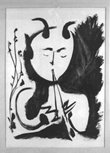 Pablo
Picasso was a very famous Spanish painter, sculptor, and draughtsman,
best known for co-founding the Cubist movement and for the wide
variety of styles with which we worked. Picasso is perhaps best
known for his Cubism style, but he was also part of the following
movements in art: The Blue Period (1901-1904), the Rose Period (1905-1907),
the African-influenced Period, Analytic Cubism (1909-1912), and
Synthetic Cubism (1912-1919). Pablo
Picasso was a very famous Spanish painter, sculptor, and draughtsman,
best known for co-founding the Cubist movement and for the wide
variety of styles with which we worked. Picasso is perhaps best
known for his Cubism style, but he was also part of the following
movements in art: The Blue Period (1901-1904), the Rose Period (1905-1907),
the African-influenced Period, Analytic Cubism (1909-1912), and
Synthetic Cubism (1912-1919).
|
| Visit gallery of artwork for Pablo Picasso |
Kâthe Kollwitz (German, 1867-1945) |
back to the top |
|
 The work of Kâthe Kollwitz, a Prussian artist, is of Social Protest:
her focus was the common man and woman. She created a series of
etchings, The Weavers Revolt, from 1884-98 based on the
peasants' strike of 1844, and a second series, Peasant Wars,
from 1902-1908. After 1920, she was increasingly involved in workers
movements, creating the woodcut series War from 1922-23
and Proletariat in 1925. Her tender images of mothers with
children focused on the needs of working-class families. The work of Kâthe Kollwitz, a Prussian artist, is of Social Protest:
her focus was the common man and woman. She created a series of
etchings, The Weavers Revolt, from 1884-98 based on the
peasants' strike of 1844, and a second series, Peasant Wars,
from 1902-1908. After 1920, she was increasingly involved in workers
movements, creating the woodcut series War from 1922-23
and Proletariat in 1925. Her tender images of mothers with
children focused on the needs of working-class families.
|
| Visit gallery of artwork for Kâthe Kollwitz |
Rufino Tamayo (Mexican, 1899-1991) |
back to the top |
|
 Born
in Oaxaca, Mexico of Zapotex parents, Rufino Tamayo moved to Mexico
City as a boy. He studied at the San Carlos Academy in 1917. His
work has been exhibited widely in Central and South America, Europe,
and the United States. He exhibited at the Weyhe Gallery in New
York in 1926. In 1946 the Palace of Fine Arts in Mexico City exhibited
a retrospective of Tamayo's work, and in 1978, the Phillips Collection
in Washington, D.C., held an individual exhibition of his work that
traveled to several museums. In 1979 a major retrospective,
Rufino Tamayo: Myth and Magic, was shown at the Solomon R.
Guggenheim Museum in New York. Born
in Oaxaca, Mexico of Zapotex parents, Rufino Tamayo moved to Mexico
City as a boy. He studied at the San Carlos Academy in 1917. His
work has been exhibited widely in Central and South America, Europe,
and the United States. He exhibited at the Weyhe Gallery in New
York in 1926. In 1946 the Palace of Fine Arts in Mexico City exhibited
a retrospective of Tamayo's work, and in 1978, the Phillips Collection
in Washington, D.C., held an individual exhibition of his work that
traveled to several museums. In 1979 a major retrospective,
Rufino Tamayo: Myth and Magic, was shown at the Solomon R.
Guggenheim Museum in New York.
|
| Visit gallery of artwork for Rufino Tamayo |
Emil Kosa, Jr. (American, 1903-1968) |
back to the top |
|
 Painter,
muralist, and lithographer Emil Kosa, Jr. was known for his California
Plein Air paintings. He was born in Paris, France and studied at
the Prague Academy and at the Ecole des Beaus-Arts in Paris. On
moving to the United States, he studied and taught at the California
Art Institute, at the Otis Art Institute, and at the Chouinard Art
Institute. He was a member of the National Academy of Art and the
American Water Color Society. His works have been exhibited throughout
the US, including the Los Angeles County Museum of Ar (LACMA)t;
Golden Gate International Exposition of 1939-1940; Art Institute
of Chicago; National Academy of Design; Philadelphia Academy of
Art; Corcoran Gallery of Art; Carnegie Institute; Denver Museum
of Art; and the Frye Museum in Seattle. Painter,
muralist, and lithographer Emil Kosa, Jr. was known for his California
Plein Air paintings. He was born in Paris, France and studied at
the Prague Academy and at the Ecole des Beaus-Arts in Paris. On
moving to the United States, he studied and taught at the California
Art Institute, at the Otis Art Institute, and at the Chouinard Art
Institute. He was a member of the National Academy of Art and the
American Water Color Society. His works have been exhibited throughout
the US, including the Los Angeles County Museum of Ar (LACMA)t;
Golden Gate International Exposition of 1939-1940; Art Institute
of Chicago; National Academy of Design; Philadelphia Academy of
Art; Corcoran Gallery of Art; Carnegie Institute; Denver Museum
of Art; and the Frye Museum in Seattle.
|
| Visit gallery of artwork for Emil Kosa, Jr. |
Rico Lebrun (1900-1964) |
back to the top |
|
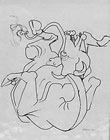 Painter,
muralist, and sculptor Rico Lebrun was born in Naples, Italy and
died in Malibu, California. He is known for strong figurative images,
frequently in black and white. In 1954, he began work on his Buchenwald
series, an exploration of the horrors of World War II. His Crucifixion
Series (as a metaphor) was the basis of a retropective exhibit in
Los Angeles in 1967. His work has been exhibited by and is in the
collections of numerous museums throughtout the U.S., South America,
and Europe. Major exhibits of his work were held in the Los Angeles
County Museum of Art in 1945, 1948, 1951 (prize), and the famous
retrospective in 1967. Other exhibits include Venice Biennal, 1950;
Whitney Museum of American Art, 1938-63, Art Gallery of Toronto
(solo), 1949, Philadelphia Academy of Fine Art, 1945, 1951-53 (gold
medal); among many others. Painter,
muralist, and sculptor Rico Lebrun was born in Naples, Italy and
died in Malibu, California. He is known for strong figurative images,
frequently in black and white. In 1954, he began work on his Buchenwald
series, an exploration of the horrors of World War II. His Crucifixion
Series (as a metaphor) was the basis of a retropective exhibit in
Los Angeles in 1967. His work has been exhibited by and is in the
collections of numerous museums throughtout the U.S., South America,
and Europe. Major exhibits of his work were held in the Los Angeles
County Museum of Art in 1945, 1948, 1951 (prize), and the famous
retrospective in 1967. Other exhibits include Venice Biennal, 1950;
Whitney Museum of American Art, 1938-63, Art Gallery of Toronto
(solo), 1949, Philadelphia Academy of Fine Art, 1945, 1951-53 (gold
medal); among many others.
|
| Visit gallery of artwork for Rico Lebrun |
Lorser Feitelson |
back to the top |
|
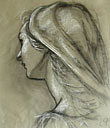 Lorser
Feitelson, a painter born in 1898, became known for abstraction,
but briefly explored mural painting of regionalist subjects. In
his signature work, Feitelson used many images and symbols that
evoke dreams and address the subconscious mind. He was a key figure
in modern art in California at a time when that area had little
exposure to avant-garde styles of which he explored a variety, including
Surrealism, Cubism, and Kinetic work. Lorser
Feitelson, a painter born in 1898, became known for abstraction,
but briefly explored mural painting of regionalist subjects. In
his signature work, Feitelson used many images and symbols that
evoke dreams and address the subconscious mind. He was a key figure
in modern art in California at a time when that area had little
exposure to avant-garde styles of which he explored a variety, including
Surrealism, Cubism, and Kinetic work.
|
| Visit gallery of artwork for Lorser Feitelson |
Raoul Dufy (French, 1877-1953) |
back to the top |
 "[Raoul
Dufy] worked in a sub-Impressionist manner until 1905, when the impact
of the Fauve movement impelled him to adopt a simplified form and
bright colors. He designed textiles, ceramics, stage sets, and costumes
as well as joyful paintings. The gay, light-hearted, decorative style,
eminently suited his range of subjects: esplanades, race courses,
regattas, Paris scenes, etc. He employed a rapid, modish calligraphic
draughtsmanship." |
| Visit gallery of artwork for Raoul Dufy |
Jose Luis Cuevas (Mexican, 1934) |
back to the top |
|
 Jose
Luis Cuevas, born in Mexico in 1934, is a self-taught artist, engraver, and
sculptor. During the 1950s Cuevas was very active in the "Rupture
Generation - Generacion de Rupture" that looked for a break
from the Mexican mural painting school with its social content message.
His symbols are of the inner conflict and turmoil of mankind. Looking
inward, he is sometimes likened to Franz Kafka. His art has a unique
style that clearly indentifies his work. He has received many awards,
including the Drawing Price at the V Biennial of Sao Paulo (1959)
and the National Prize of Science and Art of Mexico (1981), the
highest distinction awarded scientists and artists by the Mexican
Government. Jose
Luis Cuevas, born in Mexico in 1934, is a self-taught artist, engraver, and
sculptor. During the 1950s Cuevas was very active in the "Rupture
Generation - Generacion de Rupture" that looked for a break
from the Mexican mural painting school with its social content message.
His symbols are of the inner conflict and turmoil of mankind. Looking
inward, he is sometimes likened to Franz Kafka. His art has a unique
style that clearly indentifies his work. He has received many awards,
including the Drawing Price at the V Biennial of Sao Paulo (1959)
and the National Prize of Science and Art of Mexico (1981), the
highest distinction awarded scientists and artists by the Mexican
Government.
|
| Visit gallery of artwork for Jose Luis Cuevas |
Francisco Zuniga (Costa Rican/Mexican, 1912-1998) |
back to the top |
|
 Francisco Zuniga was born in Costa Rica to the sculptor Manuel Maria Zuniga in 1912. He lived in Mexico where he died in 1998. Zuniga first learned sculpture from his father and then at the School of Fine Arts in San Jose before leaving for Mexico City, where he studied at the Escuela de Talla Directa under Guillermo Ruiz and Oliverio Martinez. Francisco Zuniga was born in Costa Rica to the sculptor Manuel Maria Zuniga in 1912. He lived in Mexico where he died in 1998. Zuniga first learned sculpture from his father and then at the School of Fine Arts in San Jose before leaving for Mexico City, where he studied at the Escuela de Talla Directa under Guillermo Ruiz and Oliverio Martinez.
Incorporating primitive Aztec forms into the classical style Francisco Zuniga had been taught helped to create a regionalized style, one that focused on the bodies and forms of the natives of Central America. The majority of his work is composed of nudes, generally female, of peasant stock. With stocky bodies unfamiliar to classical sculpture, Zuniga expanded the intellectual reach of his work by mixing it with regional ethnographic studies of body type and lifestyle.
|
| Visit gallery of artwork for Francisco Zuniga |
William Pajaud (American, 1925-present) |
back to the top |
 Born and raised in New Orleans where his father was a jazz musician, William Pajaud has created work that spans more than fifty years and covers such diverse topics as traditional New Orleans Jazz Funerals, Negro Spirituals, landscapes of Thailand, and the Old Testament. He currently resides in Los Angeles. Many of his paintings are contemporary figurative in style with emphasis on design and are done with both oil and watercolor. Wet into wet transparent watercolor is a specialty. Born and raised in New Orleans where his father was a jazz musician, William Pajaud has created work that spans more than fifty years and covers such diverse topics as traditional New Orleans Jazz Funerals, Negro Spirituals, landscapes of Thailand, and the Old Testament. He currently resides in Los Angeles. Many of his paintings are contemporary figurative in style with emphasis on design and are done with both oil and watercolor. Wet into wet transparent watercolor is a specialty.
Pajaud studied at Xavier University in New Orleans, earning a Bachelor of Fine Arts Degree and exhibiting at art exhibitions of black artists. He then spent time in Chicago and in 1948 arrived in Los Angeles where he enrolled at the Chouinard Art Institute.
|
| Visit gallery of artwork for William Pajaud |
| - MID-CAREER ARTISTS AT HERITAGE GALLERY- |
Carlos Almaraz |
back to the top |
|
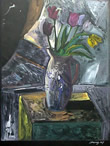 Carlos
Almaraz was born in Mexico in 1949. He was raised in Chicago and
later in Los Angeles, where he was an early participant in the Chicano
movement. Almaraz was a member of "Los Four,"the first
Chicano group to have an exhibit (in 1974) at the Los Angeles County
Museum of Art. "Los Four" were key to the development
of the urban chicano iconography through an appropriation of Mesoamerican
motifs. Carlos
Almaraz was born in Mexico in 1949. He was raised in Chicago and
later in Los Angeles, where he was an early participant in the Chicano
movement. Almaraz was a member of "Los Four,"the first
Chicano group to have an exhibit (in 1974) at the Los Angeles County
Museum of Art. "Los Four" were key to the development
of the urban chicano iconography through an appropriation of Mesoamerican
motifs.
|
| Visit gallery of artwork for Carlos Almaraz |
Alfredo Castaneda |
back to the top |
|
 Born in Mexico City in 1938, Alfredo Castaneda received a degree in architecture
from the University of Mexico and in 1969 he had his first one-man
show at the Galeria de Arte Mexicano. His surrealist imagery intrigues
viewers and his works are included in museums in Mexico, Latin America,
the United States, Europe, and Japan. Born in Mexico City in 1938, Alfredo Castaneda received a degree in architecture
from the University of Mexico and in 1969 he had his first one-man
show at the Galeria de Arte Mexicano. His surrealist imagery intrigues
viewers and his works are included in museums in Mexico, Latin America,
the United States, Europe, and Japan.
|
| Visit gallery of artwork for Alfredo Castaneda |
Ricardo Carbajal-Moss |
back to the top |
|
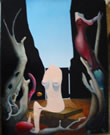 Ricardo Carbajal-Moss, known as "The surrealist artist who
makes magic with his brush." studied at the University of the
Americas in Mexico City, at the Instituto Allende in San Miguel
Allende, Mexico, and at the Otis Art Institute in Los Angeles. His
work has been exhibited widely in Mexico and California, including
exhibits at the Salon de la Plastica Mexicana in Mexico City, the
Cinco de Mayo Show at the Los Angeles Civic Center in 1975, and
the San Diego Art Institute, among others. In 1997 he won the Grumbacher
First Prize Award.
Ricardo Carbajal-Moss, known as "The surrealist artist who
makes magic with his brush." studied at the University of the
Americas in Mexico City, at the Instituto Allende in San Miguel
Allende, Mexico, and at the Otis Art Institute in Los Angeles. His
work has been exhibited widely in Mexico and California, including
exhibits at the Salon de la Plastica Mexicana in Mexico City, the
Cinco de Mayo Show at the Los Angeles Civic Center in 1975, and
the San Diego Art Institute, among others. In 1997 he won the Grumbacher
First Prize Award.
|
| Visit gallery of artwork for Ricardo Carbajal-Moss |
Willis "Bing" Davis |
back to the top |
|
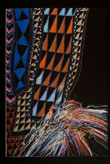 Willis "Bing" Davis was born in Greer, South Carolina but grew up in Dayton, Ohio where he lives today. He attended DePauw University in Greencastle, Indiana, graduating in 1959. He also attended the school of the Dayton Art Institute and received his Master of Education degree in 1967 from Miami University, Oxford, Ohio. Davis also pursued graduate study at Indiana State University from 1975-1976. His career as an educator includes: teaching in the Dayton Public School System; Teaching at DePauw and Miami Universities; and twenty years at Central State University (CSU) in Wilberforce, Ohio. While at CSU, Mr. Davis was also Chair of the Art Department and Director of the Paul Robeson Cultural and Performing Arts Center. He has also served as an artist-in-residence for the School of Education at the University of Dayton, and visiting scholar at Wright State University. He is Acting Treasurer of National Conference of Artists (NCA).
Willis "Bing" Davis was born in Greer, South Carolina but grew up in Dayton, Ohio where he lives today. He attended DePauw University in Greencastle, Indiana, graduating in 1959. He also attended the school of the Dayton Art Institute and received his Master of Education degree in 1967 from Miami University, Oxford, Ohio. Davis also pursued graduate study at Indiana State University from 1975-1976. His career as an educator includes: teaching in the Dayton Public School System; Teaching at DePauw and Miami Universities; and twenty years at Central State University (CSU) in Wilberforce, Ohio. While at CSU, Mr. Davis was also Chair of the Art Department and Director of the Paul Robeson Cultural and Performing Arts Center. He has also served as an artist-in-residence for the School of Education at the University of Dayton, and visiting scholar at Wright State University. He is Acting Treasurer of National Conference of Artists (NCA).
Davis’ record as an artist and a curator is equally illustrious, including exhibitions at Studio Museum of Harlem, American Craft Museum, Renwick Gallery, Maryland Institute College of Art, Savannah College of Art and Design, Anacostia Museum, National Museum of Art of Senegal West Africa, United States Embassy Accra, Ghana and Museum fur Angewandte Kunst (Museum of Applied Arts, Frankfurt, Germany.
|
| Visit gallery of artwork for Willis "Bing" Davis |
| - CONTEMPORARY ARTISTS AT HERITAGE GALLERY- |
Shaunte Johnson |
back to the top |
|
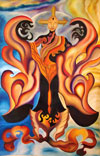 Shaunte Johnson, an emerging African American artist was born in Corpus Christi TX in 1979. After graduating College she moved to Austin, Texas where her modeling career lead her to Los Angeles, California. Shaunte' later pursued a masters degree in psychology which lead her to an interest in art therapy. Her first art exhibit in 2010 was showcased with other African American artists at the LGBT History Museum, San Francisco Art museum. In her own words "I am a self-taught artist learning from the company of self-expression." Shaunte Johnson, an emerging African American artist was born in Corpus Christi TX in 1979. After graduating College she moved to Austin, Texas where her modeling career lead her to Los Angeles, California. Shaunte' later pursued a masters degree in psychology which lead her to an interest in art therapy. Her first art exhibit in 2010 was showcased with other African American artists at the LGBT History Museum, San Francisco Art museum. In her own words "I am a self-taught artist learning from the company of self-expression."
Shaunte's works of art, influenced by the spiritual philosophy of Buddhism, are intended to be hung as a tapestry or Tanka.
|
| Visit gallery of artwork for Shaunte Johnson |
Michael Graham |
back to the top |
|
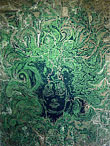 Michael Graham, born in 1982, is a Los Angeles
based artist and director who graduated with a BFA from the
University of Southern California. Growing up, Michael was constantly surrounded by artists and photographers - most notably, Richard Prince and Ed Ruscha. Michael has created his own style of "Medusa" painting or "Medusa Style" as he calls it, evolving from an original painting idea he came up with based upon our culture's dependence on technology.
Michael Graham, born in 1982, is a Los Angeles
based artist and director who graduated with a BFA from the
University of Southern California. Growing up, Michael was constantly surrounded by artists and photographers - most notably, Richard Prince and Ed Ruscha. Michael has created his own style of "Medusa" painting or "Medusa Style" as he calls it, evolving from an original painting idea he came up with based upon our culture's dependence on technology.
|
| Visit gallery of artwork for Michael Graham |
Leo Limon |
back to the top |
|
 Artist
Leo Limon was born, and still lives in Los Angeles. While he was
in high school, Limon was influenced by and was involved in the
significant Chicano Movement, "Los Four." During his time with Self-Help
Graphics, a community-based visual arts center, Limon helped to
develop the annual celebration of Dia de Los Muertos and the Atelier
Printmaking Program. Artist
Leo Limon was born, and still lives in Los Angeles. While he was
in high school, Limon was influenced by and was involved in the
significant Chicano Movement, "Los Four." During his time with Self-Help
Graphics, a community-based visual arts center, Limon helped to
develop the annual celebration of Dia de Los Muertos and the Atelier
Printmaking Program.
|
| Visit gallery of artwork for Leo Limon |
Michael Shankman |
back to the top |
|
 Born
in Colorado, Michael Shankman studied art at the University of California
at Santa Barbara and at Studio Art Centers International in Florence,
Italy. He is currently living in San Francisco. Born
in Colorado, Michael Shankman studied art at the University of California
at Santa Barbara and at Studio Art Centers International in Florence,
Italy. He is currently living in San Francisco.
|
| Visit gallery of artwork for Michael Shankman |
|

































